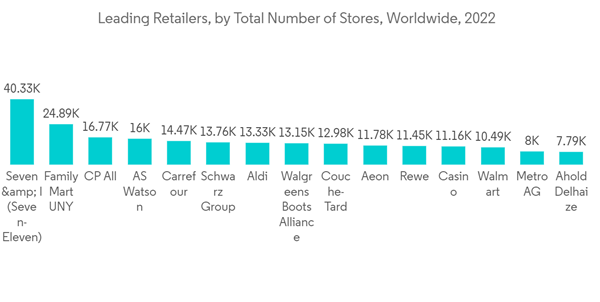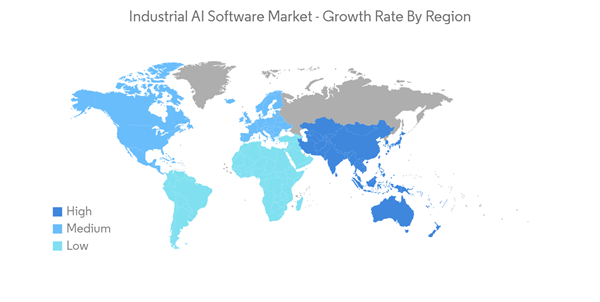Key Highlights
- Increased focus on capturing value from industrial data. This drives the need for multi-dimensional optimization, meaning AI-enabled decision-making and operational agility are becoming more critical to executives. To thrive in today's volatile market, companies must simultaneously optimize their assets and processes across business objectives such as margins, economics, sustainability, etc.
- According to the European Commission, the European AI Strategy seeks to establish the European Union (EU) as a premier AI hub and to guarantee that artificial intelligence (AI) is trustworthy and centered on people. Such a purpose is translated through specific laws and deeds into the European approach to excellence and trust. An essential part of excellence in AI is making the most of available resources and coordinating investments. The Commission intends to invest EUR1 billion annually in AI through the Digital Europe and Horizon Europe programs. Over the digital decade, it will mobilize other investments from the private sector and the Member States to reach an annual investment volume of EUR 20 billion.
- Although AI is still one of the critical technology areas, organizations require an efficient way to scale their AI practices and use AI in business to accelerate ROI in AI investment. As organizations face more significant pressure to optimize their workflows, more companies will ask BI teams to manage and develop AI/ML models. The two critical factors that will drive this boost of a new BI-based AI developer class: First, enabling BI teams with tools such as automation platforms is more scalable and more sustainable than hiring dedicated data scientists; second, because BI teams are significantly closer to the business use-cases compared to data scientists, the lifecycle from the working model's requirement will be accelerated.
- With the advancement in AI technology, it is becoming more important than ever for the government to innovate its traditional methods to achieve better citizen engagement, interoperability, and accountability. Such trends are driving the demand for AI Governance from enterprises and organizations worldwide. For instance, Google has highlighted five areas where the government, in collaboration with AI practitioners and wider civil society, can play a crucial role in clarifying expectations about AI's application on a context-specific basis. These include explainability standards, safety considerations, approaches to appraising fairness, general liability frameworks, and requirements for human-AI collaboration.
- On the contrary, While most enterprise IT procurement is limited to simply choosing suitable software or hardware and eventually deploying it to serve its purpose, the fundamental trouble with AI is that there's an ongoing requirement for initial training and working with data and calibrating it to deliver the result. There are known problems limiting normalizing data in electronic records. These include natural language processing (NLP), proprietary datasets threatening open innovation, frequent bias in the medical literature due to journal bias and even outright fraud, and the growing complexity of health data such that past data is not specific sufficiently to be useful for current predictions.
- The issues caused by the COVID-19 pandemic suggested the weaknesses in production and redistribution with changes needed to make the supply chain more resilient. An increased investment toward AI in any in-transit element across the retail supply chain was presented. The industries in the various regions then depicted the biggest problems facing the supply chains as employee illness and shortages of raw supplies. The growing industrial focus on automation in the post-pandemic scenario and the move towards digitalization will result in higher demand for analytics and AI solutions in the market, which is expected to be more prevalent among IoT users in industries.
Industrial AI Software Market Trends
Retail and Consumer Packaged Goods is Expected to Hold Significant Share of the Market
- Factors driving expansion include the ever-increasing number of internet users, smart gadgets, the necessity for surveillance and monitoring in physical stores, and government initiatives encouraging digitization. Artificial intelligence (AI) in retail is based on how firms have operated over the last few decades.
- AI solutions and Big data analytics are essential to digital business; they have the potential to alter everything from customer experience to business processes. Artificial intelligence drives faster firms' decisions in e-commerce, marketing, product management, and other business areas by decreasing the gap from insights to action. According to the United States Department of Commerce, retail sales in the United States are expected to reach USD 5.99 trillion in 2023.
- Further, the rise in retail stores would create an opportunity for AI players to develop new tools to cater to a broad range of retail customers. For instance, According to the United States Bureau of Labor Statistics, in the 3rd quarter of 2022, there were 1,061,539 private retail trade establishments in the United States, which is a rise from the 1st quarter of 2022 private retail establishments, i.e., 1,049,543. Further, according to the National Bureau of Statistics of China, there were 292,383 retail chain stores in China last year.
- Moreover, according to MIT Technology Review Insights and Amazon, about half of the retail and consumer goods industry respondents state that deploying AI can help improve customer care. This means an AI solution could take over augmented conversations to respond to client questions and lead the customer to the right agent when it cannot assist. Additionally, 47% of respondents said that AI could significantly improve inventory management by helping to manage costs and buyers' needs. AI tracks quantities of supply and demand at both e-commerce sites and physical locations, ensuring they are in sync.
- Moreover, various retail firms are adopting AI to provide better services to customers. For Example, ThredUp, an online consignment business, introduced Goody Boxes, comprising different used apparel items tailored to each customer's style. Customers keep and pay for the things they want while returning the ones they don't. An AI algorithm recalls each customer's preferences so that future boxes are more tailored to their interests. Customers prefer non-subscription boxes overlooking individual parts.
- According to the National Retail Federation, Seven & I Holdings, the parent company of the 7-Eleven retail chain, had over 40,000 retail stores in operation worldwide in 2022. 7-Eleven is a chain of convenience stores that operate in many countries globally. That year, Seven & I had more retail stores than any of the world's leading retail companies, such as Walmart, which had nearly 10,500 retail outlets, or the Schwarz Group, with some 13,750 stores. Although Walmart was not the company with the most locations, it was the world's leading retailer. Such a huge number of retail stores would create an opportunity for market players to develop new solutions to capture the market share.
North America is Expected to Hold a Significant Share.
- The market for artificial intelligence (AI) solutions in various industries is growing in North America, with the United States leading the way. In North America, the readiness for adoption and high fractional growth in replacement AI are the foremost drivers of their economic impact, which reflects the region's leading stance on artificial intelligence and its implementation. Moreover, the high automation potential is expected to occur at the regional level shortly, and it is also aiding the cause.
- According to the National Science and Technology Council report, In Fiscal Year 2022 (FY22), the Federal Government spent USD 8.76 billion USD on research and development in information technology, up USD 410 million or 4.9 percent from the year before. According to the study, USD 2.58 billion was spent on AI research and development in FY22 by all Federal research organizations. This is an increase of USD 130 million (+5.3%) from the prior fiscal year. According to the report, NSF (USD 654 million), NIH (USD 551 million), DARPA (USD 457 million), and the Department of Defense (USD 391 million) were the top funding sources for AI R&D in FY22, with DOE Office of Science (USD 130 million) following closely behind. Such massive spending on Artificial intelligence would create an opportunity for the players to develop new solutions to expand their market share.
- The benefits of AI solutions in the industry would enable the region's food and beverage players to deploy AI to commission new plants. For instance, in February 2023, SunOpta, a global pioneer fueled by the future of sustainable, plant-based, and fruit-based food and beverages, is pleased to announce the launch of its new plant-based beverage production facility in Midlothian, Texas. The new mega-factory will produce a whole line of plant-based milk, creamers, tea, and other items. Package sizes and configurations will include 16-ounce and 32-ounce packages used in food service, shelf-stable retail, and e-commerce for plant-based milk products, as well as 330-milliliter bottles used broadly in high-protein nutritious beverages.
- There is growing evidence that artificial intelligence (AI) is poised to significantly impact the practice of medicine in Canada. The development of the Critical Care Suite and the pneumothorax algorithm was made possible by the launch of GE Healthcare's Edison platform. Edison allows seamless uploading and sharing of images from partnering hospitals and provides a shared Web-based workspace on which radiologists from different organizations can curate and annotate the images, an essential prerequisite to training an algorithm. Humber River Hospital in Toronto, one of four institutions to sign a data-sharing agreement for developing the Critical Care Suite, provided 156,000 privacy-compliant chest X-rays and associated reports to GE Healthcare.
- Further, in September 2023, Google Cloud and technology company Continental announced a strategic partnership to provide innovative, flexible, and future-oriented digital solutions for the automotive industry. The partnership will combine Continental's expertise in automotive technology with Google's data and AI technologies to create a new generation of safe, efficient, and user-focused automotive solutions. Furthermore, the two parties expect to expand their strategic partnership into additional fields of collaboration in the future to build greater in-car connectivity and experiences for customers.
Industrial AI Software Industry Overview
The industrial AI software market exhibits moderate fragmentation and comprises several key players, including Siemens AG, Nvidia Corporation, and Cisco Systems, among others. Market dominance is currently concentrated among a select few major players who employ strategic collaborations to expand their market presence and enhance profitability.In June 2023, Intrinsic, an Alphabet company, announced a partnership with Siemens to explore integrations and interfaces between Intrinsic's robotics software, designed to facilitate seamless utilization of AI-based capabilities, and Siemens Digital Industries, renowned for its interoperable and open portfolio for industrial production automation and management.
In February 2023, Mastek, a reputable digital engineering and cloud transformation partner, joined forces with Netail, an innovative AI-driven retail software solutions provider. Their strategic alliance aims to empower e-commerce and Omni-channel retailers to optimize their retail value chain while attracting, converting, and retaining digital consumers. Combining Mastek's extensive expertise in digital commerce and data analytics with Netail's cutting-edge AI technology, which plays a pivotal role in decision-making related to product selection, pricing, and customer engagement, will result in a synergistic retail solution. Together, Mastek and Netail will provide online retailers with personalized merchandising, a deeper understanding of consumer behavior, an efficient user experience, a flexible assortment strategy, and real-time market visibility.
Additional Benefits:
- The market estimate (ME) sheet in Excel format
- 3 months of analyst support
This product will be delivered within 2 business days.
Table of Contents
Methodology

LOADING...










